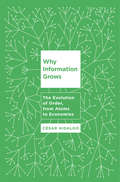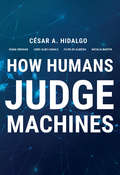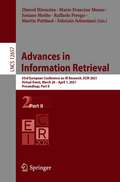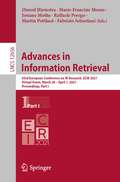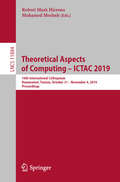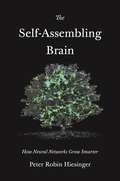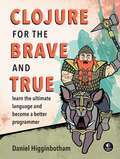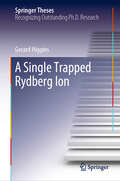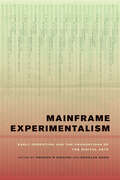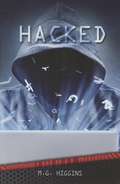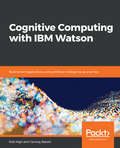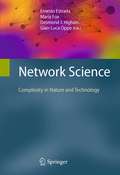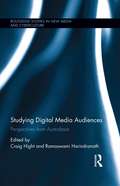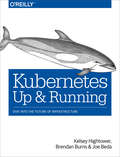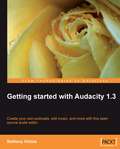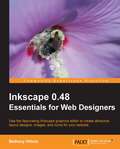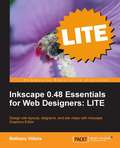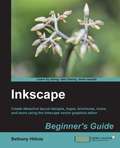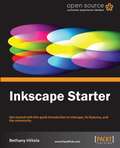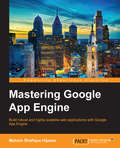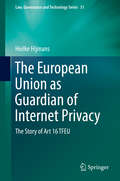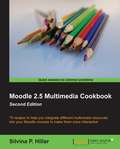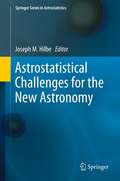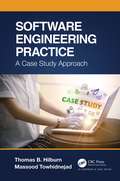- Table View
- List View
Why Information Grows: The Evolution of Order, from Atoms to Economies
by César HidalgoWhat is economic growth? And why, historically, has it occurred in only a few places? Previous efforts to answer these questions have focused on institutions, geography, finances, and psychology. But according to MIT's antidisciplinarian César Hidalgo, understanding the nature of economic growth demands transcending the social sciences and including the natural sciences of information, networks, and complexity. To understand the growth of economies, Hidalgo argues, we first need to understand the growth of order. At first glance, the universe seems hostile to order. Thermodynamics dictates that over time, order--or information--disappears. Whispers vanish in the wind just like the beauty of swirling cigarette smoke collapses into disorderly clouds. But thermodynamics also has loopholes that promote the growth of information in pockets. Although cities are all pockets where information grows, they are not all the same. For every Silicon Valley, Tokyo, and Paris, there are dozens of places with economies that accomplish little more than pulling rocks out of the ground. So, why does the US economy outstrip Brazil's, and Brazil's that of Chad? Why did the technology corridor along Boston's Route 128 languish while Silicon Valley blossomed? In each case, the key is how people, firms, and the networks they form make use of information. Seen from Hidalgo's vantage, economies become distributed computers, made of networks of people, and the problem of economic development becomes the problem of making these computers more powerful. By uncovering the mechanisms that enable the growth of information in nature and society, Why Information Grows lays bear the origins of physical order and economic growth. Situated at the nexus of information theory, physics, sociology, and economics, this book propounds a new theory of how economies can do not just more things, but more interesting things.
How Humans Judge Machines
by Cesar A. Hidalgo Diana Orghiain Jordi Albo Canals Filipa De Almeida Natalia MartinHow people judge humans and machines differently, in scenarios involving natural disasters, labor displacement, policing, privacy, algorithmic bias, and more.How would you feel about losing your job to a machine? How about a tsunami alert system that fails? Would you react differently to acts of discrimination depending on whether they were carried out by a machine or by a human? What about public surveillance? How Humans Judge Machines compares people's reactions to actions performed by humans and machines. Using data collected in dozens of experiments, this book reveals the biases that permeate human-machine interactions. Are there conditions in which we judge machines unfairly? Is our judgment of machines affected by the moral dimensions of a scenario? Is our judgment of machine correlated with demographic factors such as education or gender? César Hidalgo and colleagues use hard science to take on these pressing technological questions. Using randomized experiments, they create revealing counterfactuals and build statistical models to explain how people judge artificial intelligence and whether they do it fairly. Through original research, How Humans Judge Machines bring us one step closer tounderstanding the ethical consequences of AI.
Advances in Information Retrieval: 43rd European Conference on IR Research, ECIR 2021, Virtual Event, March 28 – April 1, 2021, Proceedings, Part II (Lecture Notes in Computer Science #12657)
by Djoerd Hiemstra Marie-Francine Moens Josiane Mothe Raffaele Perego Martin Potthast Fabrizio SebastianiThis two-volume set LNCS 12656 and 12657 constitutes the refereed proceedings of the 43rd European Conference on IR Research, ECIR 2021, held virtually in March/April 2021, due to the COVID-19 pandemic.The 50 full papers presented together with 11 reproducibility papers, 39 short papers, 15 demonstration papers, 12 CLEF lab descriptions papers, 5 doctoral consortium papers, 5 workshop abstracts, and 8 tutorials abstracts were carefully reviewed and selected from 436 submissions. The accepted contributions cover the state of the art in IR: deep learning-based information retrieval techniques, use of entities and knowledge graphs, recommender systems, retrieval methods, information extraction, question answering, topic and prediction models, multimedia retrieval, and much more.
Advances in Information Retrieval: 43rd European Conference on IR Research, ECIR 2021, Virtual Event, March 28 – April 1, 2021, Proceedings, Part I (Lecture Notes in Computer Science #12656)
by Djoerd Hiemstra Marie-Francine Moens Josiane Mothe Raffaele Perego Martin Potthast Fabrizio SebastianiThis two-volume set LNCS 12656 and 12657 constitutes the refereed proceedings of the 43rd European Conference on IR Research, ECIR 2021, held virtually in March/April 2021, due to the COVID-19 pandemic.The 50 full papers presented together with 11 reproducibility papers, 39 short papers, 15 demonstration papers, 12 CLEF lab descriptions papers, 5 doctoral consortium papers, 5 workshop abstracts, and 8 tutorials abstracts were carefully reviewed and selected from 436 submissions. The accepted contributions cover the state of the art in IR: deep learning-based information retrieval techniques, use of entities and knowledge graphs, recommender systems, retrieval methods, information extraction, question answering, topic and prediction models, multimedia retrieval, and much more.
Theoretical Aspects of Computing – ICTAC 2019: 16th International Colloquium, Hammamet, Tunisia, October 31 – November 4, 2019, Proceedings (Lecture Notes in Computer Science #11884)
by Robert Mark Hierons Mohamed MosbahThis book constitutes the refereed proceedings of the 16th International Colloquium on Theoretical Aspects of Computing, ICTAC 2019, held in Hammamet, Tunisia, in October/November 2019.The 17 revised full papers presented together with 2 keynote papers and 1 industrial paper were carefully reviewed and selected from 138 submissions.The papers are grouped in topical sections on models and transition systems; real-time and temporal logics; verification and concurrency; privacy and security; equations, types, and programming languages.
The Self-Assembling Brain: How Neural Networks Grow Smarter
by Peter Robin HiesingerWhat neurobiology and artificial intelligence tell us about how the brain builds itself How does a neural network become a brain? While neurobiologists investigate how nature accomplishes this feat, computer scientists interested in artificial intelligence strive to achieve this through technology. The Self-Assembling Brain tells the stories of both fields, exploring the historical and modern approaches taken by the scientists pursuing answers to the quandary: What information is necessary to make an intelligent neural network?As Peter Robin Hiesinger argues, “the information problem” underlies both fields, motivating the questions driving forward the frontiers of research. How does genetic information unfold during the years-long process of human brain development—and is there a quicker path to creating human-level artificial intelligence? Is the biological brain just messy hardware, which scientists can improve upon by running learning algorithms on computers? Can AI bypass the evolutionary programming of “grown” networks? Through a series of fictional discussions between researchers across disciplines, complemented by in-depth seminars, Hiesinger explores these tightly linked questions, highlighting the challenges facing scientists, their different disciplinary perspectives and approaches, as well as the common ground shared by those interested in the development of biological brains and AI systems. In the end, Hiesinger contends that the information content of biological and artificial neural networks must unfold in an algorithmic process requiring time and energy. There is no genome and no blueprint that depicts the final product. The self-assembling brain knows no shortcuts.Written for readers interested in advances in neuroscience and artificial intelligence, The Self-Assembling Brain looks at how neural networks grow smarter.
Clojure for the Brave and True: Learn the Ultimate Language and Become a Better Programmer
by Daniel HigginbothamFor weeks, months—nay!—from the very moment you were born, you’ve felt it calling to you. At long last you’ll be united with the programming language you’ve been longing for: Clojure!As a Lisp-style functional programming language, Clojure lets you write robust and elegant code, and because it runs on the Java Virtual Machine, you can take advantage of the vast Java ecosystem. Clojure for the Brave and True offers a "dessert-first" approach: you’ll start playing with real programs immediately, as you steadily acclimate to the abstract but powerful features of Lisp and functional programming. Inside you’ll find an offbeat, practical guide to Clojure, filled with quirky sample programs that catch cheese thieves and track glittery vampires.Learn how to:–Wield Clojure’s core functions–Use Emacs for Clojure development–Write macros to modify Clojure itself–Use Clojure’s tools to simplify concurrency and parallel programmingClojure for the Brave and True assumes no prior experience with Clojure, the Java Virtual Machine, or functional programming. Are you ready, brave reader, to meet your true destiny? Grab your best pair of parentheses—you’re about to embark on an epic journey into the world of Clojure!
A Single Trapped Rydberg Ion (Springer Theses)
by Gerard HigginsSystems of trapped ions and systems of ultracold Rydberg atoms are used at the forefront of quantum physics research and they make strong contenders as platforms for quantum technologies. Trapped Rydberg ions are a new hybrid technology envisaged to have both the exquisite control of trapped ion systems and the strong interactions of Rydberg atoms.In this work a single trapped Rydberg ion is experimentally investigated. A trapped strontium ion is excited to Rydberg states using two ultraviolet lasers. Effects of the strong trapping electric fields on the highly-sensitive Rydberg ion are studied. After mitigating unwanted trap effects, the ion is coherently excited to Rydberg states and a quantum gate is demonstrated. This thesis lays much of the experimental groundwork for research using this novel system.
Mainframe Experimentalism: Early Computing and the Foundations of the Digital Arts
by Hannah B. Higgins Douglas KahnMainframe Experimentalism challenges the conventional wisdom that the digital arts arose out of Silicon Valley’s technological revolutions in the 1970s. In fact, in the 1960s, a diverse array of artists, musicians, poets, writers, and filmmakers around the world were engaging with mainframe and mini-computers to create innovative new artworks that contradict the stereotypes of "computer art." Juxtaposing the original works alongside scholarly contributions by well-established and emerging scholars from several disciplines, Mainframe Experimentalism demonstrates that the radical and experimental aesthetics and political and cultural engagements of early digital art stand as precursors for the mobility among technological platforms, artistic forms, and social sites that has become commonplace today.
Hacked (Red Rhino Nonfiction)
by M. G. Higgins<p>Look out! Your computer data is not safe. There are hackers who will steal it. Sell it. Or destroy it. The hackers are getting smarter. They leave little trace as to their identities. And there are dangerous consequences for individuals, corporations, and governments. <p>Engage your most struggling readers in grades 3-8 with Red Rhino Nonfiction! This new series features high-interest topics in every content area. Visually appealing full-color photographs and illustrations, fun facts, and short chapters keep emerging readers focused. Written at a 1.5-1.9 readability level, these books include pre-reading comprehension questions and a 20-word glossary for comprehension support.</p>
Alliance Capitalism, Innovation and the Chinese State: The Global Wireless Sector (International Political Economy Series)
by Victoria HigginsThis book analyses how key 'systems integration' technical pressures, and the increasing use of collaborative alliances for market and product development are impacting on the socio technical policy directives of Chinese State leaders and the strategic behaviour of key Chinese high technology firms operating in the global wireless sector.
Cognitive Computing with IBM Watson: Build smart applications using artificial intelligence as a service
by Rob High Tanmay BakshiUnderstand, design, and create cognitive applications using Watson’s suite of APIs.Key FeaturesDevelop your skills and work with IBM Watson APIs to build efficient and powerful cognitive appsLearn how to build smart apps to carry out different sets of activities using real-world use casesGet well versed with the best practices of IBM Watson and implement them in your daily workBook DescriptionCognitive computing is rapidly infusing every aspect of our lives riding on three important fields: data science, machine learning (ML), and artificial intelligence (AI). It allows computing systems to learn and keep on improving as the amount of data in the system grows.This book introduces readers to a whole new paradigm of computing – a paradigm that is totally different from the conventional computing of the Information Age. You will learn the concepts of ML, deep learning (DL), neural networks, and AI through the set of APIs provided by IBM Watson. This book will help you build your own applications to understand, plan, and solve problems, and analyze them as per your needs. You will learn about various domains of cognitive computing, such as NLP, voice processing, computer vision, emotion analytics, and conversational systems, using different IBM Watson APIs.From this, the reader will learn what ML is, and what goes on in the background to make computers "do their magic," as well as where these concepts have been applied. Having achieved this, the readers will then be able to embark on their journey of learning, researching, and applying the concept in their respective fields.What you will learnGet well versed with the APIs provided by IBM Watson on IBM CloudLearn ML, AI, cognitive computing, and neural network principlesImplement smart applications in fields such as healthcare, entertainment, security, and moreUnderstand unstructured content using cognitive metadata with the help of Natural Language UnderstandingUse Watson’s APIs to create real-life applications to realize their capabilitiesDelve into various domains of cognitive computing, such as media analytics, embedded deep learning, computer vision, and moreWho this book is forThis book is for beginners and novices; having some knowledge about artificial intelligence and deep learning is an advantage, but not a prerequisite to benefit from this book. We explain the concept of deep learning and artificial intelligence through the set of tools IBM Watson provides.
Network Science
by Desmond J. Higham Gian-Luca Oppo Ernesto Estrada Maria FoxNetwork Science is the emerging field concerned with the study of large, realistic networks. This interdisciplinary endeavor, focusing on the patterns of interactions that arise between individual components of natural and engineered systems, has been applied to data sets from activities as diverse as high-throughput biological experiments, online trading information, smart-meter utility supplies, and pervasive telecommunications and surveillance technologies. This unique text/reference provides a fascinating insight into the state of the art in network science, highlighting the commonality across very different areas of application and the ways in which each area can be advanced by injecting ideas and techniques from another. The book includes contributions from an international selection of experts, providing viewpoints from a broad range of disciplines. It emphasizes networks that arise in nature--such as food webs, protein interactions, gene expression, and neural connections--and in technology--such as finance, airline transport, urban development and global trade. Topics and Features: begins with a clear overview chapter to introduce this interdisciplinary field; discusses the classic network science of fixed connectivity structures, including empirical studies, mathematical models and computational algorithms; examines time-dependent processes that take place over networks, covering topics such as synchronisation, and message passing algorithms; investigates time-evolving networks, such as the World Wide Web and shifts in topological properties (connectivity, spectrum, percolation); explores applications of complex networks in the physical and engineering sciences, looking ahead to new developments in the field. Researchers and professionals from disciplines as varied as computer science, mathematics, engineering, physics, chemistry, biology, ecology, neuroscience, epidemiology, and the social sciences will all benefit from this topical and broad overview of current activities and grand challenges in the unfolding field of network science.
Studying Digital Media Audiences: Perspectives from Australasia (Routledge Studies in New Media and Cyberculture)
by Craig Hight Ramaswami HarindranathAlthough many digital platforms continue to appropriate and reconfigure familiar forms of media experience, this is an environment which no longer consistently constructs an identifiable 'mass' audience in the terms understood by twentieth century audience researchers. The notion of 'audiencing' takes on different characteristics within a digital environment where platforms encourage users to upload, share and respond to content, while the platforms themselves monetise the digital traces of this activity. This environment demands new ways of thinking about audience and user engagement with media technologies, and raises significant questions on methods of conceiving and researching audience-users. This volume addresses ongoing debates in the field of audience research by exploring relevant conceptual and methodological issues concerning the systematic study of digital audiences. Drawing from work conducted by researchers based in Australia and New Zealand, the book uses theoretical frameworks and case study material which are of direct relevance to audience researchers globally.
Kubernetes: Dive into the Future of Infrastructure
by Kelsey Hightower Brendan Burns Joe BedaLegend has it that Google deploys over two billion application containers a week. How’s that possible? Google revealed the secret through a project called Kubernetes, an open source cluster orchestrator (based on its internal Borg system) that radically simplifies the task of building, deploying, and maintaining scalable distributed systems in the cloud. This practical guide shows you how Kubernetes and container technology can help you achieve new levels of velocity, agility, reliability, and efficiency.Authors Kelsey Hightower, Brendan Burns, and Joe Beda—who’ve worked on Kubernetes at Google and other organizatons—explain how this system fits into the lifecycle of a distributed application. You will learn how to use tools and APIs to automate scalable distributed systems, whether it is for online services, machine-learning applications, or a cluster of Raspberry Pi computers.Explore the distributed system challenges that Kubernetes addressesDive into containerized application development, using containers such as DockerCreate and run containers on Kubernetes, using the docker image format and container runtimeExplore specialized objects essential for running applications in productionReliably roll out new software versions without downtime or errorsGet examples of how to develop and deploy real-world applications in Kubernetes
Getting started with Audacity 1.3
by Bethany HiitolaConversational and practical, this book is full of real life examples of where and how you would use the Audacity software. Not only does it give you task-based step-by-step instructions from installation to advanced audio editing techniques, it caters to the beginner to familiarize them with all the jargon, suggests recording equipment, it walks them through a simple sample project showing off everything Audacity can do. If you are new to audio recording and editing, and particularly using the Audacity software, this book is for you. It explains everything from common audio industry terms and software basics. Technical sound engineering details and jargon are omitted to keep the book friendly and easy to understand.
Inkscape 0.48 Essentials for Web Designers
by Bethany HiitolaThis book is written in a clear conversational style, which emphasizes a practical learn-by-doing approach. Packed with illustrations and examples, this book will make the task of using Inkscape simple and straightforward.This book is written for web designers who want to add attractive visual elements to their website. It assumes no previous knowledge of Inkscape. General familiarity with vector graphics programming is recommended but not required. It will also be a useful guide for experienced Inkscape users who want to learn how to apply their skills to website design.
Inkscape 0.48 Essentials for Web Designers: LITE
by Bethany HiitolaThis book is written in a clear conversational style, which emphasizes a practical learn-by-doing approach. Packed with illustrations and examples, this book will make the task of using Inkscape simple and straightforward. This book is written for web designers who want to add attractive visual elements to their website. It assumes no previous knowledge of Inkscape. General familiarity with vector graphics programming is recommended but not required. It will also be a useful guide for experienced Inkscape users who want to learn how to apply their skills to website design.
Inkscape Beginner’s Guide
by Bethany HiitolaAs part of Packt's Beginner's Guide series, each chapter covers an aspect of working with Inkscape, with plenty of screenshots and practical examples. This book is intended for beginning graphic and web designers who want to expand their graphic software expertise. General familiarity with a graphics program is recommended, but not required.
Inkscape Starter
by Bethany HiitolaA short, simple guide with everything you need to get started, The quickest way to become productive, Learn about the main features and how to use them, Get to know the community and where to get help. If you are new to Inkscape this guide is the perfect companion for getting you off to a flying start. No previous experience with Inkscape is required as you will be walked through downloading Inkscape and installing it on your system. Become productive straightaway as you create your very first vector graphic. The list of resources in this guide will familiarize you with the Inkscape community, which is a valuable part of any Open Source project. Finally, you will see how to use seven key features of Inkscape - including using paths and layers, combining shapes, creating and editing text tools, importing and embedding images, and a list of keyboard shortcuts for text styling - which will allow you to perform simple tasks to learn the basics and set off on your own.
Mastering Google App Engine
by Mohsin Shafique HijazeeBuild robust and highly scalable web applications with Google App Engine About This Book * Get an in-depth look at how Google App Engine works under the hood * Design and model your application around Google's highly scalable distributed NoSQL datastore to unlock its full potential * A comprehensive guide to ensure your mastery of Google App Engine Who This Book Is For If you have been developing web applications in Python or any other dynamic language but have always wondered how to write highly scalable web applications without getting into system administration and other plumbing, then this is the book for you. No experience in writing scalable applications is required. What You Will Learn * Scale and develop your applications with Google App Engine's runtime environment * Get to grips with request handling mechanism and write request handlers * Deep dive into Google's distributed NoSQL and highly scalable datastore and design your application around it * Implement powerful search with scalable datastore * Perform long-running tasks in the background using task queues * Write compartmentalized apps using multi tenancy, memcache, and other Google App Engine runtime services * Handle web requests using the CGI, WSGI, and multi-threaded configurations * Deploy, tweak, and manage apps in production on Google App Engine In Detail Developing web applications that serve millions of users is no easy task, as it involves a number of configurations and administrative tasks for the underlying software and hardware stack. This whole configuration requires not only expertise, but also a fair amount of time as well. Time that could have been spent on actual application functionality. Google App Engine allows you develop highly scalable web applications or backends for mobile applications without worrying about the system administration plumbing or hardware provisioning issues. Just focus writing on your business logic, the meat of the application, and let Google's powerful infrastructure scale it to thousands of requests per second and millions of users without any effort on your part. This book takes you from explaining how scalable applications work to designing and developing robust scalable web applications of your own, utilizing services available on Google App Engine. Starting with a walkthrough of scalability is and how scalable web applications work, this book introduces you to the environment under which your applications exist on Google App Engine. Next, you will learn about Google's datastore, which is a massively scalable distributed NoSQL solution built on top of BigTable. You will examine the BigTable concepts and operations in detail and reveal how it is used to build Google datastore. Armed with this knowledge, you will then advance towards how to best model your data and query that along with transactions. To augment the powerful distributed dataset, you will deep dive into search functionality offered on Google App Engine. With the search and storage sorted out, you will get a look into performing long running tasks in the background using Google App Engine task queues along with sending and receiving emails. You will also examine the memcache to boost web application performance, image processing for common image manipulation tasks. You will then explore uploading, storing, and serving large files using Blobstore and Cloud storage. Finally, you will be presented with the deployment and monitoring of your applications in production along with a detailed look at dividing applications into different working modules. Style and approach This book is an in-depth guide where you will examine the problems in the context of highly scalable web applications. This book will take you through the libraries, services, and required configuration and finally puts everything together into a small web application that showcases all the capabilities of Google App Engine.
The European Union as Guardian of Internet Privacy
by Hielke HijmansThis book examines the role of the EU in ensuring privacy and data protection on the internet. It describes and demonstrates the importance of privacy and data protection for our democracies and how the enjoyment of these rights is challenged by, particularly, big data and mass surveillance. The book takes the perspective of the EU mandate under Article 16 TFEU. It analyses the contributions of the specific actors and roles within the EU framework: the judiciary, the EU legislator, the independent supervisory authorities, the cooperation mechanisms of these authorities, as well as the EU as actor in the external domain. Article 16 TFEU enables the Court of the Justice of the EU to play its role as constitutional court and to set high standards for fundamental rights protection. It obliges the European Parliament and the Council to lay down legislation that encompasses all processing of personal data. It confirms control by independent supervisory authorities as an essential element of data protection and it gives the EU a strong mandate to act in the global arena. The analysis shows that EU powers can be successfully used in a legitimate and effective manner and that this subject could be a success story for the EU, in times of widespread euroskepsis. It demonstrates that the Member States remain important players in ensuring privacy and data protection. In order to be a success story, the key stakeholders should be prepared to go the extra mile, so it is argued in the book. The book is based on academic research for which the author received a double doctorate at the University of Amsterdam and the Vrije Universiteit Brussels. It builds on a long inside experience within the European institutions, as well as within the community of data protection and data protection authorities. It is a must read in a time where the setting of EU privacy and data protection is changing dramatically, not only as a result of the rapidly evolving information society, but also because of important legal developments such as the entry into force of the General Data Protection Regulation. This book will appeal to all those who are in some way involved in making this regulation work. It will also appeal to people interested in the institutional framework of the European Union and in the role of the Union of promoting fundamental rights, also in the wider world.
Moodle 2.5 Multimedia Cookbook - Second Edition
by Silvina P. HilarWith practical examples presented in the style of recipes, this book is designed for you to be able to dip in and out as you need, only using the multimedia options that you want at the time.This cookbook is designed specifically for teachers who want to begin creating interactive and engaging Moodle courses by utilizing the multimedia capabilities of Moodle.
Astrostatistical Challenges for the New Astronomy (Springer Series in Astrostatistics #1)
by Joseph M. HilbeAstrostatistical Challenges for the New Astronomy presents a collection of monographs authored by several of the disciplines leading astrostatisticians, i.e. by researchers from the fields of statistics and astronomy-astrophysics, who work in the statistical analysis of astronomical and cosmological data. Eight of the ten monographs are enhancements of presentations given by the authors as invited or special topics in astrostatistics papers at the ISI World Statistics Congress (2011, Dublin, Ireland). The opening chapter, by the editor, was adapted from an invited seminar given at Los Alamos National Laboratory (2011) on the history and current state of the discipline; the second chapter by Thomas Loredo was adapted from his invited presentation at the Statistical Challenges in Modern Astronomy V conference (2011, Pennsylvania State University), presenting insights regarding frequentist and Bayesian methods of estimation in astrostatistical analysis. The remaining monographs are research papers discussing various topics in astrostatistics. The monographs provide the reader with an excellent overview of the current state astrostatistical research, and offer guidelines as to subjects of future research. Lead authors for each chapter respectively include Joseph M. Hilbe (Jet Propulsion Laboratory and Arizona State Univ); Thomas J. Loredo (Dept of Astronomy, Cornell Univ); Stefano Andreon (INAF-Osservatorio Astronomico di Brera, Italy); Martin Kunz ( Institute for Theoretical Physics, Univ of Geneva, Switz); Benjamin Wandel ( Institut d'Astrophysique de Paris, Univ Pierre et Marie Curie, France); Roberto Trotta (Astrophysics Group, Dept of Physics, Imperial College London, UK); Phillip Gregory (Dept of Astronomy, Univ of British Columbia, Canada); Marc Henrion (Dept of Mathematics, Imperial College, London, UK); Asis Kumar Chattopadhyay (Dept of Statistics, Univ of Calcutta, India); Marisa March (Astrophysics Group, Dept of Physics, Imperial College, London, UK).
Software Engineering Practice: A Case Study Approach (Chapman And Hall/crc Innovations In Software Engineering And Software Development Ser.)
by Thomas B. Hilburn Massood TowhidnejadThis book is a broad discussion covering the entire software development lifecycle. It uses a comprehensive case study to address each topic and features the following: A description of the development, by the fictional company Homeowner, of the DigitalHome (DH) System, a system with "smart" devices for controlling home lighting, temperature, humidity, small appliance power, and security A set of scenarios that provide a realistic framework for use of the DH System material Just-in-time training: each chapter includes mini tutorials introducing various software engineering topics that are discussed in that chapter and used in the case study A set of case study exercises that provide an opportunity to engage students in software development practice, either individually or in a team environment. Offering a new approach to learning about software engineering theory and practice, the text is specifically designed to: Support teaching software engineering, using a comprehensive case study covering the complete software development lifecycle Offer opportunities for students to actively learn about and engage in software engineering practice Provide a realistic environment to study a wide array of software engineering topics including agile development Software Engineering Practice: A Case Study Approach supports a student-centered, "active" learning style of teaching. The DH case study exercises provide a variety of opportunities for students to engage in realistic activities related to the theory and practice of software engineering. The text uses a fictitious team of software engineers to portray the nature of software engineering and to depict what actual engineers do when practicing software engineering. All the DH case study exercises can be used as team or group exercises in collaborative learning. Many of the exercises have specific goals related to team building and teaming skills. The text also can be used to support the professional development or certification of practicing software engineers. The case study exercises can be integrated with presentations in a workshop or short course for professionals.
